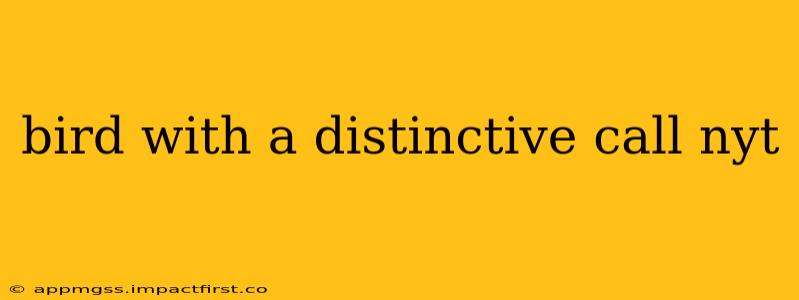The New York Times, and indeed many other publications, often feature articles highlighting the wonders of the natural world. One frequent topic is the remarkable diversity of bird calls. Identifying a bird solely by its song can be a rewarding experience for bird watchers of all levels. But with thousands of species, pinpointing a bird based on its unique call requires patience and a keen ear. This guide will help you navigate the world of distinctive bird calls, offering strategies for identification and addressing some frequently asked questions.
What are some birds with distinctive calls?
Many birds possess calls so unique they're instantly recognizable. Consider the Northern Cardinal's clear, whistled "cheer-cheer-cheer," the easily identifiable "bob-white" of the Bobwhite Quail, or the mournful cooing of Mourning Doves. These are just a few examples; the variety is astounding. Regional variations also exist, adding another layer of complexity and fascination to the identification process. The best way to learn these calls is through direct experience. Listening to recordings, attending bird walks, and using bird identification apps can significantly enhance your ability to recognize distinctive bird songs.
How can I identify a bird by its call alone?
Identifying a bird by its call alone requires a multi-pronged approach. First, consider the habitat where you heard the call. A bird call in a dense forest will likely belong to a different species than one heard in an open field. Second, pay attention to the characteristics of the call itself: Is it a whistle, a chirp, a trill, or a series of distinct notes? Is it high-pitched or low-pitched? Long or short? Finally, utilize resources such as field guides, bird identification apps (like Merlin Bird ID or eBird), and online audio recordings to compare the call you heard to known species. Remember that practice makes perfect; the more you listen, the better you will become at recognizing different calls.
Are bird calls influenced by their environment?
Yes, a bird's environment can subtly influence its call. Factors like habitat type, ambient noise levels, and even the presence of other birds can all play a role. While the fundamental structure of a species' call remains consistent, variations can occur. This is particularly true in noisy urban environments where birds may adapt their calls to be heard above the background cacophony.
Do different birds have different calls for different purposes?
Absolutely! Birds use a wide array of vocalizations for various purposes, including attracting mates, defending territories, warning of danger, and communicating with their young. A bird's alarm call, for instance, will often differ significantly from its mating call. Understanding this complexity adds another layer to the challenge—and reward—of bird identification.
What resources can I use to learn more about bird calls?
There's a wealth of resources available for learning about bird calls. Start with comprehensive field guides specific to your region. Many excellent online resources offer recordings of bird calls. Consider joining local birding clubs or attending bird walks led by experienced birders. These opportunities provide valuable hands-on learning and the chance to learn from others.
Why are bird calls important for conservation efforts?
Monitoring bird calls is a vital tool in conservation biology. By tracking changes in bird populations and vocalizations, scientists can gain insights into the health of ecosystems and the effects of habitat loss, pollution, and climate change. The unique calls of individual species can serve as an early warning system for potential environmental threats.
By carefully observing and listening to the avian world around you, you can unlock the secrets of these fascinating creatures. The next time you hear a distinctive bird call, remember these tips, and embrace the challenge of identifying its source. Happy birding!
